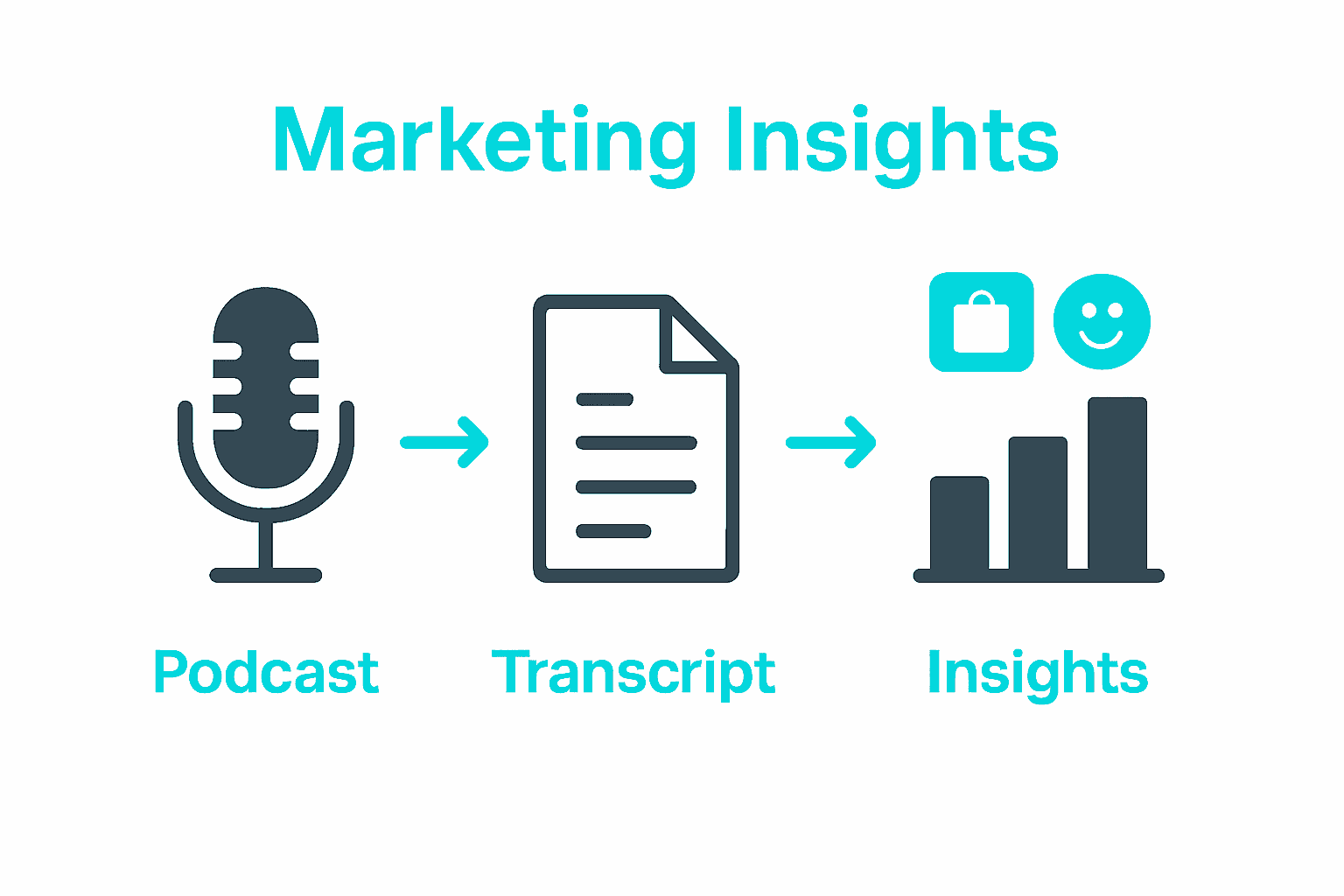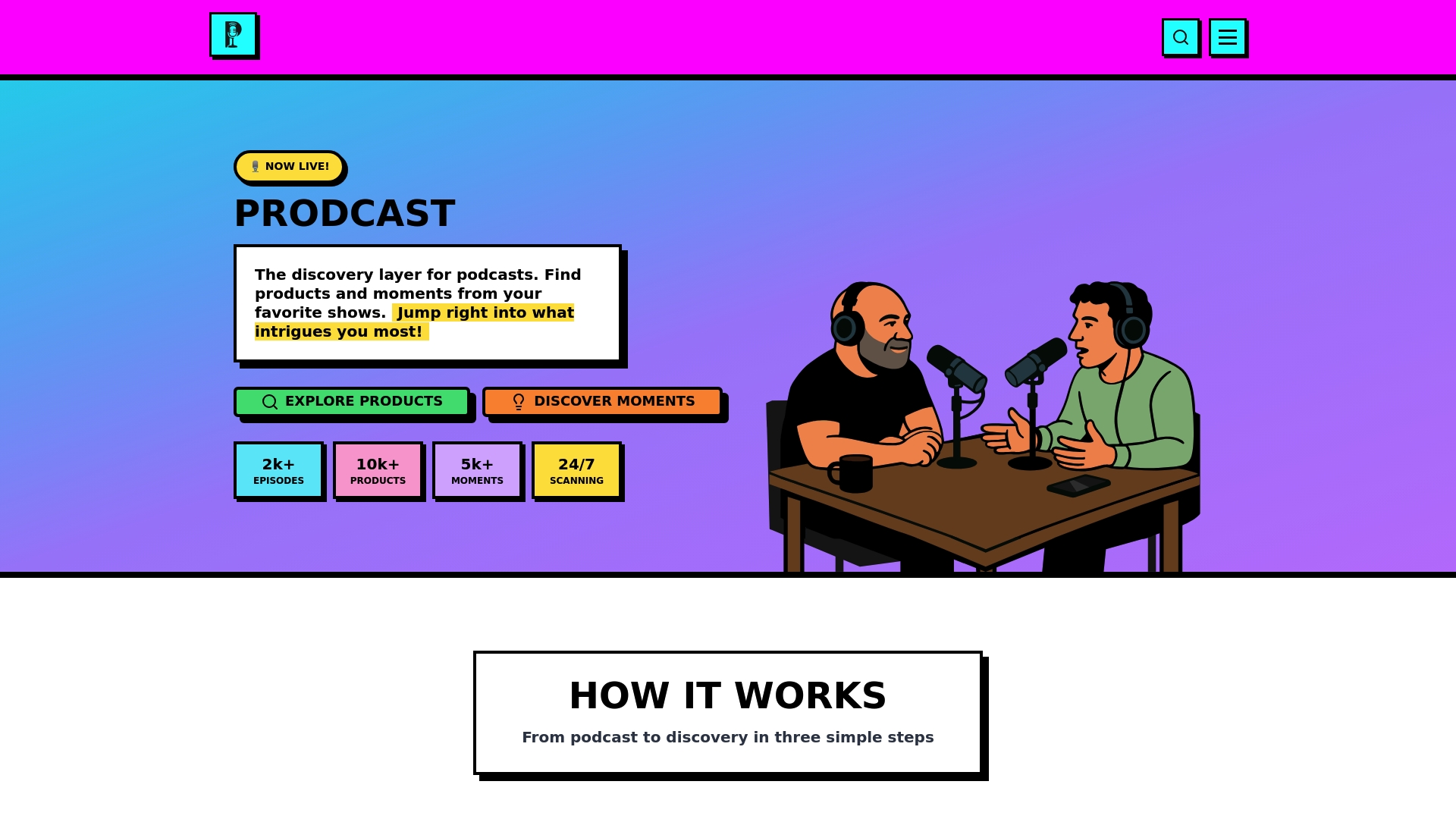CATEGORIES
TAGS
Data-Driven Marketing Strategy for Podcast Product Discovery

Over 464 million people globally now listen to podcasts, yet most brands have no idea which products are being talked about during these shows. With such a huge, untapped conversation happening, podcast transcript analysis offers a powerful window into product trends, listener interests, and real-time marketing opportunities. By turning raw audio into structured insights, you can discover what truly matters to your target audience and create smarter strategies that outpace the competition.
Table of Contents
- Step 1: Analyze Podcast Transcripts For Product Mentions
- Step 2: Identify Trending Categories And Consumer Insights
- Step 3: Integrate Product Discovery Features For Listeners
- Step 4: Craft Data-Driven Content Campaigns For Engagement
- Step 5: Monitor Performance And Optimize Marketing Tactics
Quick Summary
| Key Point | Explanation |
|---|---|
| 1. Use AI for Transcript Analysis | Leverage AI tools to accurately transcribe podcasts and extract product mentions for deeper insights. |
| 2. Analyze Listener Preferences | Identify trending product categories by understanding listener demographics and content themes from popular podcasts. |
| 3. Integrate Product Discovery Features | Enhance the podcast experience by adding interactive features that allow instant access to products mentioned during episodes. |
| 4. Craft Personalized Campaigns | Develop data-driven content campaigns tailored to specific audience interests to increase engagement and effectiveness. |
| 5. Monitor Performance Metrics | Track detailed listener engagement metrics beyond downloads to refine marketing tactics and content strategies. |
Step 1: Analyze Podcast Transcripts for Product Mentions
Successful podcast transcript analysis involves transforming spoken content into structured data that reveals product trends and expert recommendations. According to research from ACL Anthology, advanced techniques now allow us to generate abstractive summaries that link specific audio segments with product mentions.
To analyze podcast transcripts effectively, start by using AI transcription tools that convert audio into searchable text. Look for platforms that offer accurate word recognition and speaker identification. Focus on identifying brand names, product references, and contextual details around those mentions. The ACL Anthology research demonstrates the potential power of this approach by highlighting a dataset of over 100,000 transcribed podcast episodes that can reveal rich product insights.
A pro tip for maximizing your transcript analysis: dont just collect mentions. Understand the sentiment and discussion context. Was the product praised? Criticized? Recommended? These nuanced insights transform raw data into actionable marketing intelligence.
 As you refine your analysis process, youll uncover hidden trends that could transform how brands understand podcast audience preferences.
As you refine your analysis process, youll uncover hidden trends that could transform how brands understand podcast audience preferences.
Ready to dive deeper? The next step involves categorizing and quantifying those product mentions across different podcast genres and audiences.

Step 2: Identify Trending Categories and Consumer Insights
Understanding podcast listener preferences is crucial for identifying trending product categories and consumer insights. Pew Research Center reveals fascinating trends from analyzing 451 top-ranked U.S. podcasts which show true crime, politics, entertainment, and self-help as the most prevalent topics.
To effectively identify trending categories, leverage podcast data analysis tools that track listener engagement and topic popularity. Look for patterns in product mentions, listener demographics, and discussion themes. University of Florida Research highlights the importance of understanding listener motivations, which can provide deeper insights into consumption behaviors and preferences. When analyzing podcast data, pay attention to context not just volume track whether products are recommended, criticized, or casually mentioned.
A key strategy is to cross reference trending topics with audience sentiment and product discussions.
For instance, a wellness podcast might discuss nutrition supplements differently than a fitness podcast. If you want to dig deeper into understanding how podcast trends can reveal product opportunities, our comprehensive guide breaks down the process step by step.
Ready to transform podcast conversations into actionable marketing intelligence? The next step involves mapping consumer insights to specific product strategies.
Step 3: Integrate Product Discovery Features for Listeners
Transforming podcast listening into a seamless shopping experience requires smart product discovery features that connect audience interests with relevant recommendations. ACL Anthology research reveals groundbreaking techniques for creating grounded abstractive summaries that enable listeners to access specific audio segments related to product mentions.
To integrate effective product discovery features, leverage advanced transcript analysis tools that can pinpoint exact moments where products are discussed. The key is creating interactive experiences that allow listeners to instantly explore products mentioned during a podcast. ACL Anthology research supports this approach by providing comprehensive datasets that facilitate the development of sophisticated product discovery tools. Consider implementing features like clickable product links, instant price comparisons, and direct purchase options that appear precisely when a product is mentioned.
A pro tip for maximizing product discovery: focus on context and sentiment. Not all product mentions are created equal. Was the product recommended? Criticized? Used as an example? Understanding these nuances helps create more intelligent recommendation systems. If you want to explore how dynamic podcast ads can revolutionize product discovery, our detailed guide offers strategic insights for marketers and listeners alike.
Ready to turn podcast conversations into shopping opportunities? The next step involves measuring and optimizing your product discovery features for maximum audience engagement.
Step 4: Craft Data-Driven Content Campaigns for Engagement
Creating compelling podcast content campaigns requires a deep understanding of listener preferences and consumption behaviors. Pew Research Center provides critical insights into the most popular podcast topics like true crime, politics, entertainment, and self help which can guide your content strategy.
To develop data-driven content campaigns, leverage listener consumption data to create targeted experiences. University of Florida Research highlights the importance of understanding listener motivations beyond surface level metrics. Analyze listener demographics, engagement patterns, and content preferences to craft campaigns that resonate deeply. This means moving beyond generic content to create hyper personalized experiences that speak directly to specific audience segments and their unique interests.
A critical strategy is segmenting your audience based on granular data points. Not all listeners want the same content experience. Some seek deep educational insights while others want quick entertainment. If you want to dive deeper into understanding audience engagement, our comprehensive guide offers strategic frameworks for creating meaningful connections.
Ready to transform your podcast content from generic to extraordinary? The final step involves measuring campaign performance and iterating based on real listener feedback.
Step 5: Monitor Performance and Optimize Marketing Tactics
Pew Research Center reveals critical insights into podcast performance benchmarking, highlighting the importance of tracking key metrics beyond simple download numbers. Effective performance monitoring goes far deeper than surface level statistics and requires a nuanced approach to understanding audience engagement.
To optimize marketing tactics, leverage comprehensive analytics that capture listener behavior and content interaction. University of Florida Research emphasizes the significance of understanding listener motivations to refine marketing strategies. Focus on metrics like listener retention rates, episode completion percentages, and audience demographic shifts. These granular insights allow you to create targeted content and marketing approaches that resonate with specific listener segments.
A pro tip for performance optimization: treat your analytics as a living, breathing roadmap. Dont just collect data analyze and act on it. Continuous iteration based on listener feedback and behavioral trends is key to staying relevant. If you want to dive deeper into understanding podcast analytics, our comprehensive guide provides strategic frameworks for transforming data into actionable marketing intelligence.
Ready to turn your podcast marketing from good to exceptional? Your journey of data driven optimization is just beginning.
Unlock the Power of Podcast Product Discovery with AI
Podcast marketers and listeners face a big challenge: how to turn vast amounts of spoken content into clear, actionable insights about trending products and audience preferences. This article highlights the need for data-driven marketing strategies that analyze product mentions, sentiment, and consumer trends across genres. If you want to stop guessing what your audience cares about and start uncovering real-time product insights from podcast conversations, you are in the right place.
Prodcast is built to solve this exact challenge. Our AI-powered platform transforms raw podcast transcripts into searchable, structured data revealing which brands and products are gaining momentum across thousands of shows. Whether you are looking to spot which supplements dominate health podcasts or what tech gadgets entrepreneurs are buzzing about, Prodcast’s real-time discovery engine gives you clear answers and actionable recommendations.
Explore how Prodcast bridges audio content and commerce with tools designed to identify product mentions, analyze sentiment, and deliver targeted insights. Start turning podcast conversations into marketing opportunities and shopping experiences today by visiting Prodcast’s homepage.
Discover market trends that really matter

Take control of your podcast marketing and product discovery efforts now. Visit Prodcast to experience AI-powered insights that reveal what your audience is truly hearing and buying. Don’t miss your chance to lead with data-driven storytelling and dynamic product discovery features that transform podcasts into profit engines.
Frequently Asked Questions
How can I analyze podcast transcripts to discover product mentions?
To analyze podcast transcripts effectively, start by using AI transcription tools to convert audio into searchable text. Focus on identifying brand names and product references, understanding their context and sentiment, and categorizing the mentions to uncover actionable marketing intelligence.
What strategies can I use to identify trending product categories in podcasts?
Leverage podcast data analysis tools to track listener engagement and topic popularity, focusing on patterns in product mentions and listener demographics. By cross-referencing this data with audience sentiment, you can pinpoint trending categories and tailor marketing strategies accordingly.
How can I integrate product discovery features in podcasts to improve listener experience?
To integrate effective product discovery features, use transcript analysis tools to pinpoint exact moments where products are discussed. Implement interactive elements like clickable links and instant price comparisons during these moments to create a seamless shopping experience for listeners.
What are the key metrics to monitor for optimizing podcast marketing tactics?
Focus on comprehensive analytics that capture listener behavior, such as retention rates and episode completion percentages. By analyzing these metrics and iterating your content based on feedback, you can enhance audience engagement and refine your marketing strategies over time.
How can I create data-driven content campaigns based on listener preferences?
Utilize listener consumption data to design targeted content experiences that resonate with specific audience segments. Segment your audience based on motivations and preferences to craft hyper-personalized campaigns that address their unique interests.